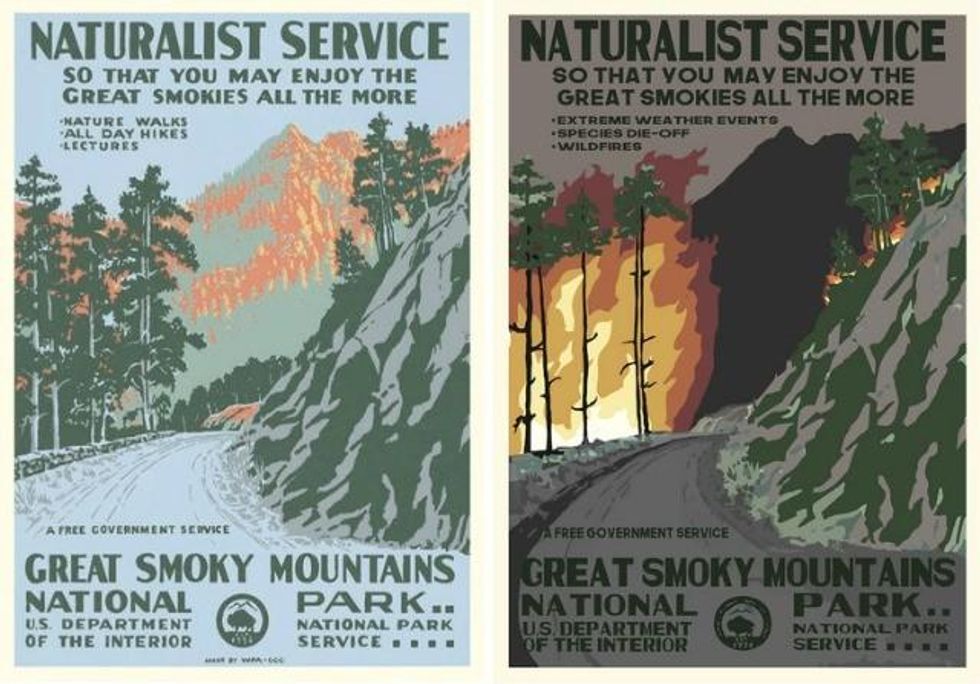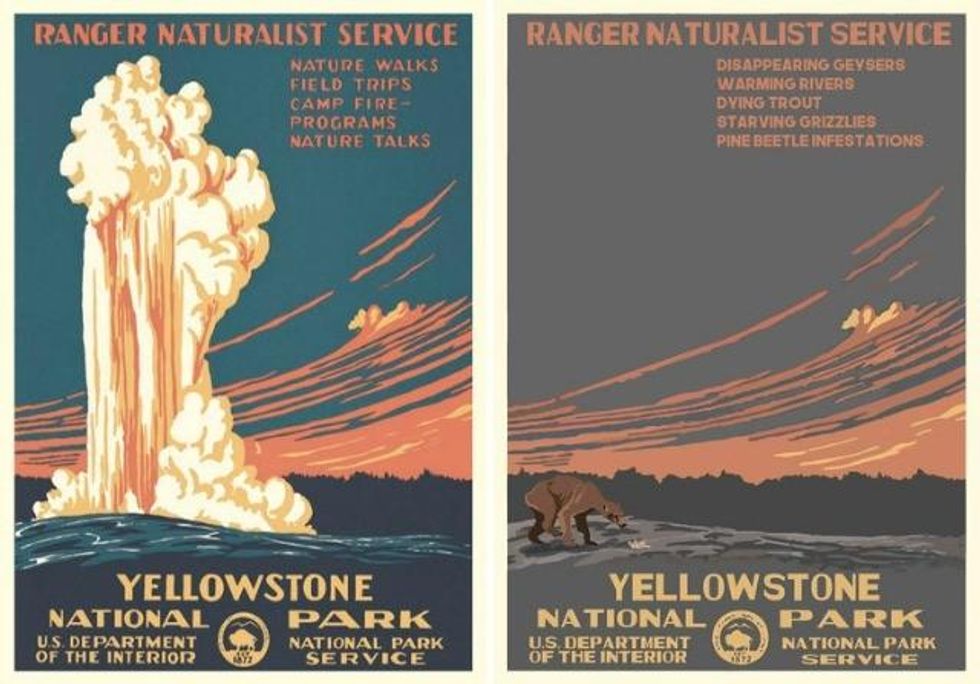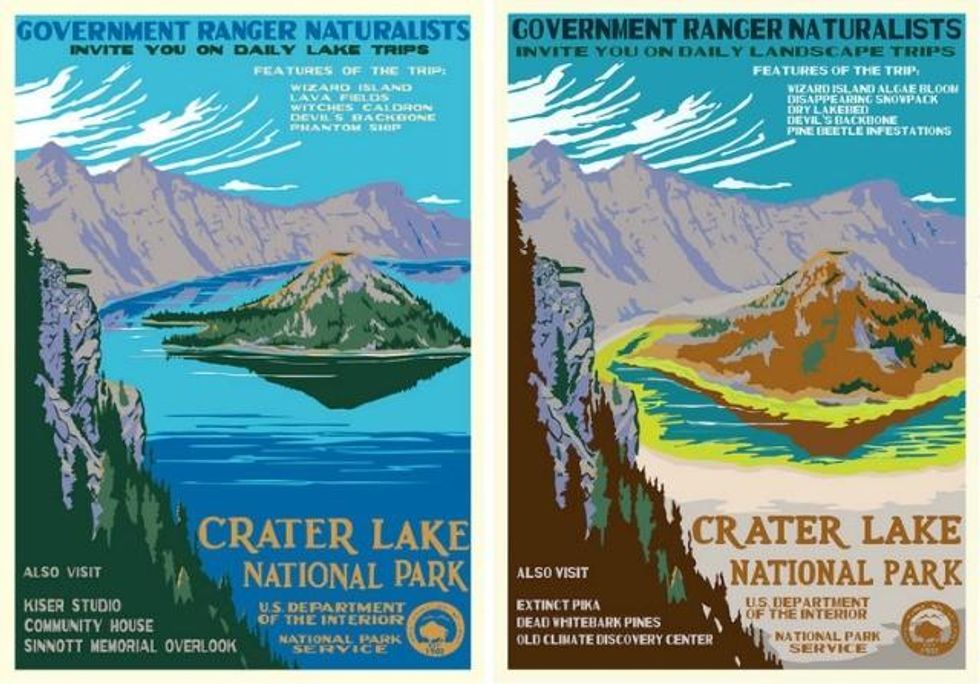Artist Redesigns National Parks Posters for 2050, Showcasing Climate Devastation
Starving grizzlies, wildfires, and massive algae blooms take over re-imagined posters in one artist's call to climate action
In a project meant to galvanize people to take action on climate, the Berkeley, California-based artist Hannah Rothstein has redesigned iconic National Parks posters for the year 2050 to showcase the devastation to come if climate change goes unchecked.
"We have the ability to outsmart the issues highlighted in National Parks 2050, but we need to act now."
--Hannah Rothstein, artist
While the Trump administration is rolling back climate policies and reinvigorating the fossil fuel industry, Rothstein calls on viewers to push back with her series National Parks 2050, depicting the terrifying ramifications of such government actions.
The classic posters, originally created by artists working for the Works Progress Administration from 1938 to 1941, have been re-imagined so that instead of blue lakes, towering forests, craggy snow-peaked mountains, and tropical lagoons, the posters showcase horrible algae blooms, dead redwoods, snow-free mountain peaks, and rising seas.

"I think a lot of people recognize the posters and that was key to the success [of this project], to have something familiar to people," Rothstein told Climate Central. "They could be familiar, but then have to look twice to figure out what was different."
With this project, Rothstein seeks to make the climate crisis more visceral to viewers. As VICE's Beckett Mufson writes, "Once you've seen an emaciated Smokey the Bear plodding through a barren landscape, it's hard not to want to call Congress."

"The changes shown are based on information from the parks' .gov sites, scientific reports, and reputable news articles about climate change," Rothstein told Mufson.
"I was only able to include an abbreviated list of potential changes on each poster," Rothstein added. "The predicted changes are actually much more far-reaching than what's highlighted here. I'd encourage people to read up on the predicted changes and start talking about them. Acknowledgement and dialogue are the first steps towards positive change, and we need to get moving on this!"
"We have the ability to outsmart the issues highlighted in National Parks 2050, but we need to act now," Rothstein observes. "From Franklin to Fuller, America has been made its greatest by embracing ingenuity and innovation. If we dive headfirst into inventing for a brighter future, we can prevent National Parks 2050 from becoming a reality."

All of National Parks 2050 can be viewed on Rothstein's website.
An Urgent Message From Our Co-Founder
Dear Common Dreams reader, The U.S. is on a fast track to authoritarianism like nothing I've ever seen. Meanwhile, corporate news outlets are utterly capitulating to Trump, twisting their coverage to avoid drawing his ire while lining up to stuff cash in his pockets. That's why I believe that Common Dreams is doing the best and most consequential reporting that we've ever done. Our small but mighty team is a progressive reporting powerhouse, covering the news every day that the corporate media never will. Our mission has always been simple: To inform. To inspire. And to ignite change for the common good. Now here's the key piece that I want all our readers to understand: None of this would be possible without your financial support. That's not just some fundraising cliche. It's the absolute and literal truth. We don't accept corporate advertising and never will. We don't have a paywall because we don't think people should be blocked from critical news based on their ability to pay. Everything we do is funded by the donations of readers like you. Will you donate now to help power the nonprofit, independent reporting of Common Dreams? Thank you for being a vital member of our community. Together, we can keep independent journalism alive when it’s needed most. - Craig Brown, Co-founder |
In a project meant to galvanize people to take action on climate, the Berkeley, California-based artist Hannah Rothstein has redesigned iconic National Parks posters for the year 2050 to showcase the devastation to come if climate change goes unchecked.
"We have the ability to outsmart the issues highlighted in National Parks 2050, but we need to act now."
--Hannah Rothstein, artist
While the Trump administration is rolling back climate policies and reinvigorating the fossil fuel industry, Rothstein calls on viewers to push back with her series National Parks 2050, depicting the terrifying ramifications of such government actions.
The classic posters, originally created by artists working for the Works Progress Administration from 1938 to 1941, have been re-imagined so that instead of blue lakes, towering forests, craggy snow-peaked mountains, and tropical lagoons, the posters showcase horrible algae blooms, dead redwoods, snow-free mountain peaks, and rising seas.

"I think a lot of people recognize the posters and that was key to the success [of this project], to have something familiar to people," Rothstein told Climate Central. "They could be familiar, but then have to look twice to figure out what was different."
With this project, Rothstein seeks to make the climate crisis more visceral to viewers. As VICE's Beckett Mufson writes, "Once you've seen an emaciated Smokey the Bear plodding through a barren landscape, it's hard not to want to call Congress."

"The changes shown are based on information from the parks' .gov sites, scientific reports, and reputable news articles about climate change," Rothstein told Mufson.
"I was only able to include an abbreviated list of potential changes on each poster," Rothstein added. "The predicted changes are actually much more far-reaching than what's highlighted here. I'd encourage people to read up on the predicted changes and start talking about them. Acknowledgement and dialogue are the first steps towards positive change, and we need to get moving on this!"
"We have the ability to outsmart the issues highlighted in National Parks 2050, but we need to act now," Rothstein observes. "From Franklin to Fuller, America has been made its greatest by embracing ingenuity and innovation. If we dive headfirst into inventing for a brighter future, we can prevent National Parks 2050 from becoming a reality."

All of National Parks 2050 can be viewed on Rothstein's website.
In a project meant to galvanize people to take action on climate, the Berkeley, California-based artist Hannah Rothstein has redesigned iconic National Parks posters for the year 2050 to showcase the devastation to come if climate change goes unchecked.
"We have the ability to outsmart the issues highlighted in National Parks 2050, but we need to act now."
--Hannah Rothstein, artist
While the Trump administration is rolling back climate policies and reinvigorating the fossil fuel industry, Rothstein calls on viewers to push back with her series National Parks 2050, depicting the terrifying ramifications of such government actions.
The classic posters, originally created by artists working for the Works Progress Administration from 1938 to 1941, have been re-imagined so that instead of blue lakes, towering forests, craggy snow-peaked mountains, and tropical lagoons, the posters showcase horrible algae blooms, dead redwoods, snow-free mountain peaks, and rising seas.

"I think a lot of people recognize the posters and that was key to the success [of this project], to have something familiar to people," Rothstein told Climate Central. "They could be familiar, but then have to look twice to figure out what was different."
With this project, Rothstein seeks to make the climate crisis more visceral to viewers. As VICE's Beckett Mufson writes, "Once you've seen an emaciated Smokey the Bear plodding through a barren landscape, it's hard not to want to call Congress."

"The changes shown are based on information from the parks' .gov sites, scientific reports, and reputable news articles about climate change," Rothstein told Mufson.
"I was only able to include an abbreviated list of potential changes on each poster," Rothstein added. "The predicted changes are actually much more far-reaching than what's highlighted here. I'd encourage people to read up on the predicted changes and start talking about them. Acknowledgement and dialogue are the first steps towards positive change, and we need to get moving on this!"
"We have the ability to outsmart the issues highlighted in National Parks 2050, but we need to act now," Rothstein observes. "From Franklin to Fuller, America has been made its greatest by embracing ingenuity and innovation. If we dive headfirst into inventing for a brighter future, we can prevent National Parks 2050 from becoming a reality."

All of National Parks 2050 can be viewed on Rothstein's website.

